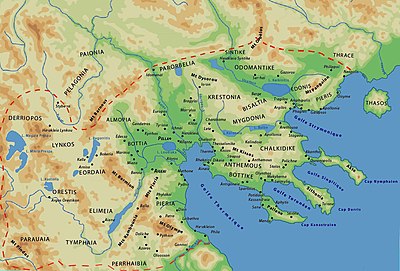Elimiotis
Elimiotis ( Greek Ελιμιώτις ), also called Elimeia ( Ελιμεία ), in ancient times referred to the mountainous landscape of Greece that rises in the arch of the Aliakmonas river . This river and with it the Lake Polyfytos marks the east, south and west borders of this landscape. Today it belongs to the municipality of Kozani in the Regional District of Kozani in the region of Western Macedonia on.
In ancient times, Elimiotis was bordered by the Epirotian landscapes of Paraueia and Tymphaia in the west and southwest , and the Thessalian landscapes of Perrhaibia and Pieria in the south and east . In the north at the place Siatista Elimiotis bordered Orestis , with which it formed the Upper Macedonian districts together with Eordaia , Lynkestis and Pelagonia . Important localities of Elimiotis were Aiani and Elimeia .
According to Thucydides , Elimiotis was next to the Lynkestis the original home of the Macedonians , who expanded from there to the fertile Netherlands on the thermal Gulf . According to Strabo, but the people of Elimiotai, like that of the Orestai and Pelagonen, the ethnic group of would Epirotes consulted and was only later were assimilated into the tribal Association of Macedonians. The Macedonian rule over the Elimiotis becomes tangible in the 5th century BC, from the reign of Alexander I , since the princely house that existed from this period was related to the royal house, if not descended from it. After the princes of the Elimiotis initially tried to defend their independence from the Macedonian kings, they came across at the latest in the time of Amyntas III. under their suzerainty.
One of the first marriages of King Philip II with Phila , the sister of the last known prince, Derdas III , is indicative of this. Philip II's capture in the Second Olympian War seems to have been used as a pretext to subordinate Elimiotis, as well as the other regions Orestis, Lynkestis, Tympheia and Eordaia, to the kingship. Members of the royal families were now sent to the royal court in Pella for training and education , where they had to vouch for the loyalty of their families as hostages and to be ideologically bound to the royal family themselves.
Some well-known companions of Alexander the Great were members of the princely families of the Upper Macedonian highlands. In his army , a Pezhetairoi taxi was made up of warriors from the Elimiotis.
Personalities
The Princely House:
- Arrhidaios (son or son-in-law of King Alexander I )
-
Derdas I (called 433/2 BC), son of the previous one
-
Sirras , presumably the son of the previous one, successively son-in-law of Arrhabaios I of Lynkestis and of King Archelaos I.
- Eurydice , wife of King Amyntas III.
-
Derdas II (called 382 BC), probably son of the previous one
- The III. (Named 350 BC), probably son of the previous one
- Phila, sister of Derdas III, wife of King Philip II of Macedon
- Machatas, brother of Derdas III. and Phila, probably father of:
-
Sirras , presumably the son of the previous one, successively son-in-law of Arrhabaios I of Lynkestis and of King Archelaos I.
-
Derdas I (called 433/2 BC), son of the previous one
Other people:
- Koinos († 326 BC), an officer of Alexander
- Kleandros († 324 BC), an officer of Alexander and probably a brother of Koinos
literature
- Fritz Geyer: Macedonia up to Philip II's accession to the throne. In: Historische Zeitschrift , Vol. 30 (1930), pp. 1–148.
- AB Bosworth: Philip II and Upper Macedonia , In: The Classical Quarterly , 21 : 93-105 (1971).
Individual evidence
- ↑ Thucydides 2, 99, 2.
- ↑ Strabo 9, 5, 11.
- ↑ a b Scholion to Thucydides 1, 57, 3.
- ↑ Amyntas III. had settled a border dispute between Elimiotis and the Thessalian Polis Doliche . See AJB Wace and MS Thompson: A Latin Inscription from Perrhaebia , In: Annual of the British School at Athens Vol. 17 (1910/11), pp. 193-204.
- ↑ Satyros of Kallatis , fragment 5 in Athenaios 13, 557c.
- ↑ see Geyer, pp. 79-80.
- ^ Athenaios 13, 557c.
- ^ Athenaios 13, 557c.
- ↑ Diodorus 17, 57, 2.
